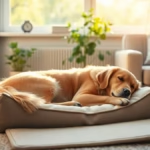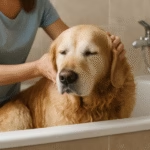Outdoor Activities Senior Golden Retrievers Can Still Enjoy — I keep my old golden moving with gentle walks, soft surfaces, and low‑impact fun. I time routes to avoid heat and fatigue, watch his stride to protect joints, and discovered soothing hydrotherapy and calm pool swims that ease arthritis. I boost his brain with scent games and slow puzzle walks, take short shaded hikes and gentle beach wading, and use a supportive harness and plenty of breaks. I always check with the vet and stop if he looks sore or stressed — because I am his proud coach, snack dispenser, and occasional towel.
Key Takeaway
- Slow, short walks on soft grass.
- Gentle swims in calm, shallow water.
- Sniffing and exploring easy, flat trails.
- Basking in the shade and quiet picnic naps.
- Low‑impact fetch with soft toys and short tosses.
I keep him moving with gentle walks and low‑impact exercise for senior golden retrievers
Movement for an old golden isn’t about marathons; it’s about rhythm and joy. I pick short, predictable routes so he gets sniffing and people‑watching without wearing out. I mix light walks with nose work and slow play so he uses his brain and muscles without pounding his hips.
Outdoor Activities Senior Golden Retrievers Can Still Enjoy include sniff walks, gentle swims, short off‑leash checks in fenced areas, and calm fetch sessions. For structured guidance I lean on safe and beneficial exercise ideas and specific low‑impact exercises for arthritis. The payoff is simple: he moves easier, sleeps better, and still lights up when I say walk. My goal is daily motion that keeps joints limber and spirits high.
I time short routes to avoid heat and fatigue
I walk in cooler parts of the day — early morning or late evening — and plan escape points: benches, shady trees, and water stations. A ten‑minute walk that leaves him eager is better than a forty‑minute march that leaves him stiff. For hot days I follow special summer care tips and carry extra fluids, using hydration strategies for seniors. I learn his limits from pace and mood, not a stopwatch.
I watch his stride and pace to protect joints
Small gait changes—toe dragging, shorter steps, or a stiffer hip—tell me when to pull back. If he wants to sniff, I let him. If he trots happily, we allow brief bursts then slow down. Low‑impact options like swimming, grass walking, and gentle inclines keep muscles active without slamming joints; when I need practical solutions I consult resources on mobility issues and practical adaptations.
I use soft surfaces and short bursts for safe joints
I pick grass, packed dirt, or indoor rugs and keep activity bursts short — two to five minutes of brisk motion, then a calm break. A soft surface cushions joints and short bursts prevent fatigue.
| Surface | Why I like it | When I use it |
|---|---|---|
| Grass | Cushions joints and paws | Daily park or yard walks |
| Packed dirt | Stable with some give | Neighborhood loops |
| Carpet / rugs | Gentle for indoor play | Rainy days, recovery |
If you’re adapting the home or yard, check ideas on making the environment senior‑friendly.
- Time walks for cool hours, carry water, and reward slow progress.
I discovered swimming and hydrotherapy that ease arthritis
Water takes weight off the joints and lets them move differently than on land. Short sessions (10–15 minutes to start) warmed his muscles and reduced stiffness. Making therapy feel like play — fetching soft toys in the pool — kept him eager to return. For structure and precautions I followed guidance on hydrotherapy benefits and safety and looked into canine physical therapy approaches.
| Thing I tracked | Why it mattered | My usual range |
|---|---|---|
| Water temp | Too cold = stiff; too warm = tired | 28–32°C (82–90°F) |
| Session time | Short builds confidence | 10–20 min |
| Entry type | Affects stress | Ramp or steps |
| Vest fit | Keeps head up, prevents sinking | Snug, comfy |
I choose calm water and shallow pools
Calm water (no waves, quiet pumps) lowers anxiety. Shallow pools or ramps let him enter and exit without drama. I taught him steps with treats so pools felt safe.
I use a canine life vest and slow entries
A life vest is a confidence jacket; the top handle helps me steady him. I never rushed him in — I went first, sat on the steps, called him, and eased him down. Slow, positive exposure matters.
I check vet approval and signs of tiredness
Before pool days I confirm with the vet and watch for labored breathing, wobbliness, or refusal to enter. If he’s stiff or pants hard, we stop. Familiarize yourself with signs of pain and discomfort so you can spot problems early.
- Vet clearance and health limits
- Short warm‑ups, then pool
- Watch breathing, gait, and enthusiasm — stop if any drop
I boost his brain with scent games and outdoor enrichment
Short sniff sessions are our secret sauce. I hide tiny treats in grass and watch him methodically work like a gold‑digging prospector. That slow focus is mental work, not just exercise. For ideas I draw on posts about keeping a senior golden’s mind active and other mental enrichment activities tailored to older dogs.
| Activity | Time | Why it helps |
|---|---|---|
| Grass sniff hunt | 10–15 min | Gentle movement and nose work |
| Puzzle walk | 10–20 min | Mental challenges plus fresh smells |
| Rest & massage | 5–10 min | Lowers stress, helps joints |
Outdoor Activities Senior Golden Retrievers Can Still Enjoy are low‑impact and high‑joy when you plan them this way.
I hide treats to encourage sniffing and slow movement
I scatter tiny treats and give hints at first, then praise when he finds them. Flat, shaded spots are best; vary treats to keep curiosity high. If he tires, I stop — the goal is happy noses and calm paws. Rotating appropriate toys and scent cues keeps things novel.
I rotate puzzle walks to keep him curious
Different routes create novelty without distance: three short routes a week, 10–20 minute outings with built‑in rests, swapping a small toy or scent between walks. If he’s eager, we stay a bit longer; if he lags, we head home.
- Reward slow success; stop if he shows heavy panting, tucked tail, stiffness, or frozen staring.
I still take short hikes with adaptive outdoor play tips
Short, slow hikes with sniff breaks keep joints moving and heads happy. Flat, shaded trails with good footing are my go‑to — riverwalks, canal paths, or greenways with benches. When terrain gets tricky I use adaptations recommended for mobility‑limited goldens.
Trail planning & gear
| Trail length | Max time (approx) | Break frequency |
|---|---|---|
| Short stroll (<1 mile) | 15–30 minutes | Every 5–10 minutes |
| Easy trail (1–2 miles) | 30–60 minutes | Every 10–15 minutes |
| Longer walk (2–3 miles) | 60–90 minutes | Not ideal — frequent rests |
Essentials:
- Collapsible water bowl, bottled water, ice packs
- Foldable ramp or portable steps
- Short leash and training lead
- Lightweight blanket/mat, small towel, meds, booties
I practice the ramp at home so he trusts it, keep a gentle pace, and make breaks regular and fun. For packing and practical gear ideas see essential equipment and supplies.
I let him do beach wading to cool off and exercise gently
Wading gives gentle resistance and eases stiffness. Short sessions, lots of breaks, and praise for small tail wags make it feel like a soft gym. He usually chooses ankle to knee depth — his sweet spot.
Beach checklist
| Condition | Why it matters | My rule |
|---|---|---|
| Water movement | Strong surf stresses balance | Choose calm bays/coves |
| Depth | Deep water increases effort | Stick to ankle–knee depth |
| Crowds/noise | Startle risk | Visit quiet times |
- Rinse salt off paws and belly after play to prevent irritation. Check between toes, towel dry, and praise.
- Supervise every splash and avoid rough surf; cut the session if he looks unsure or tired.
For seasonal guidance, pair beach outings with summer care tips and hydration reminders from hydration advice.
I use simple gear and pacing to keep outdoor activities safe
Less fuss beats high‑tech gadgets. A supportive harness, a soft‑handled leash, and non‑slip booties cover most needs. I keep a small pack with water, treats, and a towel. For starter gear and fit tips see recommended equipment for seniors.
| Gear / Pacing | Why I use it | Quick tip |
|---|---|---|
| Supportive harness | Spreads pressure, helps lift | Fit snug — two fingers under strap |
| Non‑slip booties | Protect pads from heat/rough ground | Put on at home to acclimate |
| Short, frequent outings | Match lower stamina | Aim 10–20 min, 2–4 times daily |
Fitting harness & booties
- Slide harness on with loosened straps, buckle, then adjust two‑finger fit.
- Put booties on one paw at a time with treats; walk indoors first.
Schedule shorter, more frequent outings
I traded one long hike for three short strolls. Mix movement with mental games: sniff walk, five‑minute treasure hunt, slow lap. After each outing I check paws, hips, and mood; if he limps or is unusually stiff for more than a day, I call the vet or review comfort measures for arthritic goldens.
Conclusion
I keep it simple and joyful: short, gentle walks on soft surfaces, calm hydrotherapy, brain‑boosting scent games, shaded short hikes, and careful beach wading. I rely on a supportive harness, pack water and treats, watch his stride, and always check with the vet. Small bursts and plenty of rest beat one long heroic march.
Outdoor Activities Senior Golden Retrievers Can Still Enjoy are often low‑key but deeply rewarding — he moves easier, sleeps deeper, and still greets a walk like it’s the Super Bowl. I’m proud, a little neurotic, and utterly delighted every time his tail tells me we’ve got this. Want more tips and silly stories? Read about my everyday joys with my senior golden and other real stories of seniors who thrived.

Rafael Souza is a digital marketing strategist and lifelong dog enthusiast. Passionate about Golden Retrievers, he shares practical, research-based tips to help owners provide healthier and happier lives for their furry companions.





